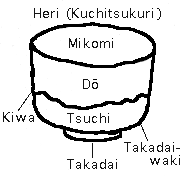Furuta Oribe, original name Furuta Shigenari.
Japanese tea master, born 1544, Mino province [now in Gifu prefecture], Japan, died July 6, 1615, Kyōto
The slight assymetry in this 'chawan,' and also the variation in the glaze was not part of the potter's intention. I like using the word associated with Pure Land Buddhism; 'jinen' which means 'of itself.' The very best of 'chawan' have something of the 'of itself' quality.
Teabowl, with Hanshan and Shide Design, iron brown (sabi-e) underglaze
Chawan (Teabowl)
Seiji,Tenmoku-chawan and Ido-chawan are made in China or Korea. Raku-chawan,Seto and Seto and Ogi are Wamono, made in Japan.
Plain chawan such as Korai-chawan and Raku-chawan are used for koicha(thick tea). And fancy chawan, for usucha(thin tea). A pot chawan is used in Ro season(November through April),and a shallow chawan is used in Furo season(May through October).
A Nezumi-Shino chawan made by a Japanese potter (and one that fulfils the traditional criteria)
Blue hagi-yaki chawan (tea bowl) was made by Yamane Seigan, who first created the blue hagi glaze and style
Honami Koetsu Black Raku Chawan--Shigure
Tsujimura Shiro
Koie Ryoji
They dance and play. These chawan are alive.
Gohon Hagi Chawan Tea Bowl, Ninsei
A finely molded thin walled Gohon Chawan dating from the later Edo period enclosed in an antique wooden box bearing the Ninsei Mark on the base indicating it was potted in Kyoto. There is a black lacquer repair to a hairline crack in the side. The age darkened base is the definitive Hagi Wari-Kodai Notched foot. The Chawan is 4-1/4 inches (11 cm) diameter, 2-3/4 inches (7 cm) tall.
Nezumi-shino-chawan-momoyama-period-BTN
Piece by Arakawa.


















No hay comentarios:
Publicar un comentario